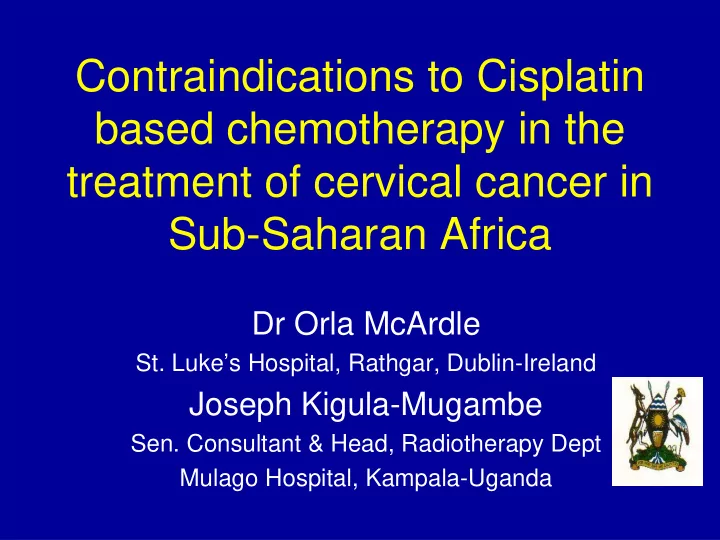

Contraindications to Cisplatin based chemotherapy in the treatment of cervical cancer in Sub-Saharan Africa Dr Orla McArdle St. Luke’s Hospital, Rathgar, Dublin-Ireland Joseph Kigula-Mugambe Sen. Consultant & Head, Radiotherapy Dept Mulago Hospital, Kampala-Uganda
Introduction • The majority of Cervical cancer patients live in developing World (Parkin et al, 2002) • Uganda incidence is 44.1/100,000 (11) compared to 4-11/100,000 in the developed world • Multiple social-economic factors lead to late presentation of Cervical cancer • Co-existing HIV and other infections, poor nutritional status and anemia make treatment difficult in Sub-Saharan Africa
Introduction • Concomitant chemoradiotherapy confers an overall survival of 10-16% (Lukka et al 2002,Green et al, 2005) • Now standard of care • It however presents multiple challenges with implications for allocation of scanty resources in Sub-Saharan Africa with a low resource setting. • We conducted a prospective study to assess the proportion of patients with cervical cancer considered suitable for chemotherapy in our department in Kampala, Uganda
Materials and Methods • All patients presenting with biopsy proven cervical cancer from Aug 2005 – June 2006 were eligible for the study. • They had standard work up to assess suitability including: H&E, KPS, EUA, CBC, RFTS and LFTS, USS (Abdomen and Pelvis) and whenever possible HIV testing
Exclusion criteria for Cisplatin • Stage 1A and stage IV A & B • HIV status positive, • KPS less than 60 • Age > 70 years • Hydronephrosis • Haemoglobin < 8 gm/dl • WBC < 2,000/ µL • Platelets < 100,000/µL • Creatinine > 97µmol/L • Previous surgery (as it is difficult to assess extent of surgery & positive margins from the reports)
Results • 314 patients were referred in the 10 months study period • Only 47 patients (15.1%) were eligible • 190 patients were NOT eligible • In 77 cases (24.4%) eligibility could not be established as work up was incomplete • 37 patients (11.6%) were proven to be HIV positive but in 38.4% HIV sero-status was not established
Frequency of exclusion criteria Exclusion criteria No (=314) % Stage 1A 4 1.1 Stage IV A & B 44 14.0 Age > 70 years 11 3.5 Hydronephrosis 99 31.4 HIV positive 37 11.6 Haemoglobin < 8gm/dl 55 17.4 WBC < 2,000/µL - - Platelets < 100,000/µL 4 1.2 Postoperative cases 41 12.8 Creatinine > 97µmol/L 47 15.1
Multiple exclusion criteria • The most frequently encountered exclusion criteria were hydronephrosis and anaemia • Cut off point of 8 gm/dl led to exclusion of 55 pts, if 10 g/dl used � additional 11 pts • Hydronephrosis was in 99 pts, 44% of which had bilateral hydronephrosis • 29 pts (29.3%) of those with hydronephrosis had abnormal creatinine levels • 96 pts (50.5%) of the 190 pts had multiple exclusion criteria (HIV positive pts were more likely to have multiple criteria (p=0.0000001)
Frequency of multiple exclusion criteria No of exclusion HIV positive HIV negative criteria n=37 n=153 No (%) No (%) 1 4 (11) 90 (59) 2 19 (51) 33 (22) 3 11 (30) 26 (17) 4 3 (8) 4 (3)
Discussion • 35-40% of dept workload at Mulago Hospital, Kampala is composed of cervical cancer • Exclusion criteria were selected with a view of selecting the patients most likely to benefit from chemoradiation while minimizing its side effects as the facilities for supportive care are limited • 60.5% of our cervical cancer patients were not suitable for chemoradiation at presentation • Apart from anemia & hydronephrosis, most of the other criteria are not easily modified by clinical intervention
Anemia and hydronephrosis • Anemia represents a double disadvantage for our pts as it prevents the chemotherapy while it is itself associated with poorer treatment outcomes (2,6,7). • Cut off at 8 g/dL was chosen because at this level transfusion with 2-3 units can reverse the anemia. In practice transfusion is not readily available & multiple transfusions difficult • 99 pts had hydronephrosis & in our setting placing of ureteral stents is not possible
Stage IVA and age above 70 years • These are not absolute contraindications • Represents only a pragmatic & cautious approach on our part • Omitting these criteria increases the total eligible patients by 29 (9.2%) leaving the ineligible ones at 47.7%
HIV/AIDS • 11.6% of our patients were HIV patients (UNAIDS reported HIV prevalence of 6.7% in general population in Uganda in 2005) • At present there is no proven survival benefit for chemoradiation in HIV positive cervical cancer patients • Radiation therapy alone has been shown to produce increased toxicity in HIV positive patients & chemoradiation has clear implications (2,9). • HIV/AIDS pts are treated with chemoradiation as part of an ongoing IAEA coordinated multinational randomized controlled trial (CRP 13120) in our dept.
Radiotherapy alone? • There are however reports which show impressive results that can be achieved with radiotherapy alone in the developing world setting (Saibishkumar EP et al, 2006)
Conclusions • Our study showed that only a small proportion of our patients were likely to benefit from chemoradiotherapy with weekly Cisplatin. • This illustrates difficulties of applying a “standard” cervical cancer treatment to the developing world where the majority of these cancers exist. • Introduction of chemoradiotherapy might therefore not have as a major effect on treatment outcomes for the group as a whole. • Alternative chemotherapy agents especially those not associated with potential renal complications of Cisplatin should be investigated.
Conclusions - 2 • The provision of accessible radiotherapy facilities for the treatment of existing disease and • The introduction of national screening / vaccination programmes to prevent cervical cancer and to catch it while it is in its early stages should be the major priorities in the developing world setting.
Acknowledgements & references
THANK YOU FOR YOUR ATTENTION
Recommend
More recommend